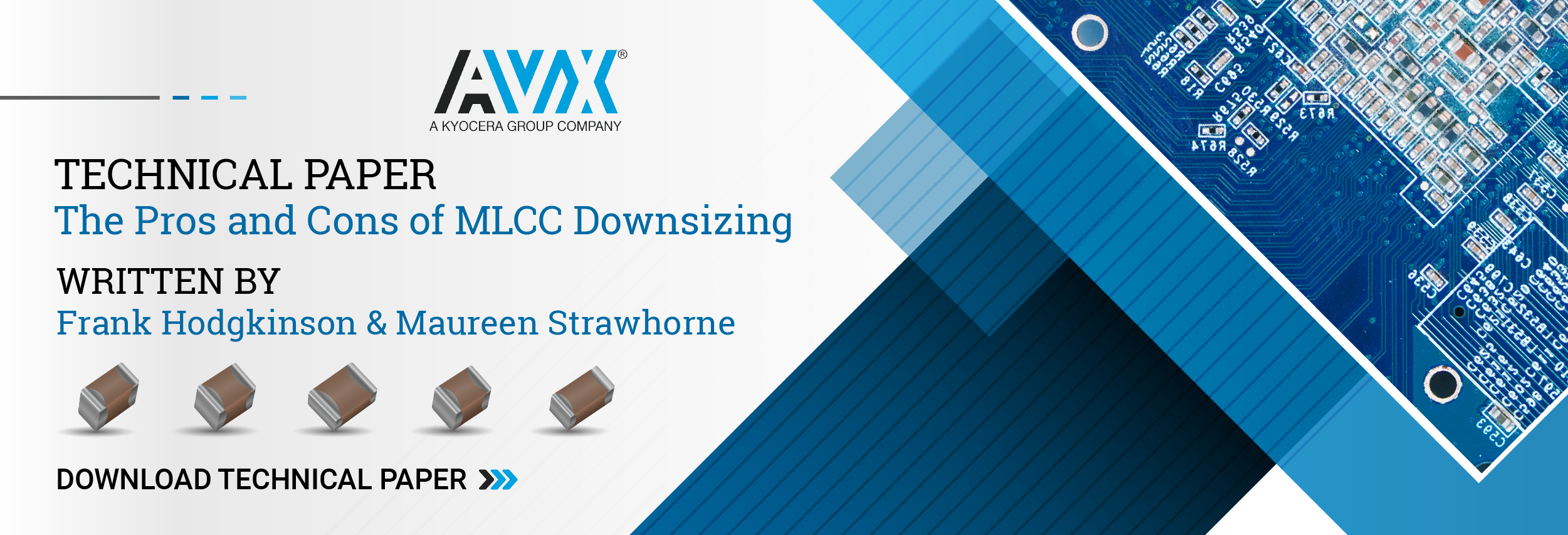The Pros and Cons of MLCC Downsizing
Written By: Frank Hodgkinson | Maureen Strawhorne Abstract:
As integrated circuits (ICs) continue to pack more functionality into smaller packages, the need for bulk off-chip capacitance remains. In resonant circuits, such as phase-lock-loops (PLLs) and switching regulators, precision class one ceramic capacitor may be required. Such capacitors must maintain a tight capacitance range over process, voltage, and temperature variation (PVT) for the host IC to meet its performance specifications. In contrast, class two ceramic capacitors are required for nearly every IC in the form of decoupling and bypass capacitance. They may also be found in amplifier circuits, simple filters, and linear regulators where their function is less dependent on tightly specified impedance requirements.Such requirements for class two capacitors often create a trap for the unwitting designer, who might naturally focus on voltage rating, size, and cost when choosing these devices. This is especially true when the top-level application is overly constrained by form factor. One can imagine the selection filtering process: start with an approximate capacitor value (i.e., 100 nF), choose a voltage rating with some reasonable headroom (i.e., 6.3 V), and finally, find the smallest surface mount (SMT) package (i.e., 0402) and cost combination to create room for other components and PCB routing.
Considering voltage rating and capacitance separately from package size may seem reasonable, but therein lies the potential trap. As capacitor sizes have grown smaller and smaller, manufacturers have developed new technologies to increase capacitance density to achieve standard value-package combinations. In doing so, dependencies have also been introduced that may create unexpected surprises during testing.
DOWNLOAD TECHNICAL PAPER
As integrated circuits (ICs) continue to pack more functionality into smaller packages, the need for bulk off-chip capacitance remains. In resonant circuits, such as phase-lock-loops (PLLs) and switching regulators, precision class one ceramic capacitor may be required. Such capacitors must maintain a tight capacitance range over process, voltage, and temperature variation (PVT) for the host IC to meet its performance specifications. In contrast, class two ceramic capacitors are required for nearly every IC in the form of decoupling and bypass capacitance. They may also be found in amplifier circuits, simple filters, and linear regulators where their function is less dependent on tightly specified impedance requirements.
Such requirements for class two capacitors often create a trap for the unwitting designer, who might naturally focus on voltage rating, size, and cost when choosing these devices. This is especially true when the top-level application is overly constrained by form factor. One can imagine the selection filtering process: start with an approximate capacitor value (i.e., 100 nF), choose a voltage rating with some reasonable headroom (i.e., 6.3 V), and finally, find the smallest surface mount (SMT) package (i.e., 0402) and cost combination to create room for other components and PCB routing.
Considering voltage rating and capacitance separately from package size may seem reasonable, but therein lies the potential trap. As capacitor sizes have grown smaller and smaller, manufacturers have developed new technologies to increase capacitance density to achieve standard value-package combinations. In doing so, dependencies have also been introduced that may create unexpected surprises during testing.


